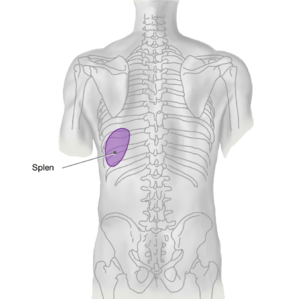Milz/en: Unterschied zwischen den Versionen
Becher (Diskussion | Beiträge) (Die Seite wurde neu angelegt: „<div style="text-align: center"> | <!--[segmenter_snapshot splen 0]-->View on <i>Facies costalis</i><!--[/]--> | <!--[segmenter_snapshot splen 1]-->View on <i>…“) |
Becher (Diskussion | Beiträge) (Die Seite wurde neu angelegt: „The spleen lies intraperitoneally in the left upper abdomen. Between the strong connective tissue threads that run into the interior of the organ lies an arran…“) |
||
| Zeile 9: | Zeile 9: | ||
</div> | </div> | ||
| − | + | The spleen lies intraperitoneally in the left upper abdomen. Between the strong connective tissue threads that run into the interior of the organ lies an arrangement of reticular connective tissue formed by fibroblasts (splenic pulp). The splenic pulp is divided into the red and white pulp. The shape of the spleen is very variable. However, it is surrounded by a relatively solid, connective tissue capsule, which is why its outer shape is quite constant and reminiscent of a coffee bean. It is about 7 cm wide, 4 cm high and 11 cm long. <br> | |
| − | + | The red pulp is strongly supplied with blood in the living organ (high number of erythrocytes), hence the name and colour. It makes up the largest part of the parenchyma. <br> | |
| − | + | The white pulp, on the other hand, contains lymphocytes and is therefore part of the lymphatic system. They have the task of immunological defence reaction. | |
<h2>Projektion der Milz auf den Rumpf</h2> | <h2>Projektion der Milz auf den Rumpf</h2> | ||
Version vom 3. Januar 2020, 14:15 Uhr
Inhaltsverzeichnis
Structure of the spleen (Splen)
| View on Facies costalis | View on Facies visceralis |
<segmenter>https://dornheim.cloud/index.php/apps/segmenter/embedding/view?identifier=hHyjjNIiVFKb</segmenter>
The spleen lies intraperitoneally in the left upper abdomen. Between the strong connective tissue threads that run into the interior of the organ lies an arrangement of reticular connective tissue formed by fibroblasts (splenic pulp). The splenic pulp is divided into the red and white pulp. The shape of the spleen is very variable. However, it is surrounded by a relatively solid, connective tissue capsule, which is why its outer shape is quite constant and reminiscent of a coffee bean. It is about 7 cm wide, 4 cm high and 11 cm long.
The red pulp is strongly supplied with blood in the living organ (high number of erythrocytes), hence the name and colour. It makes up the largest part of the parenchyma.
The white pulp, on the other hand, contains lymphocytes and is therefore part of the lymphatic system. They have the task of immunological defence reaction.
Projektion der Milz auf den Rumpf
Die Milz liegt im linken Oberbauch und ist im gesunden, normalen Zustand nicht tastbar. Da sie nicht mit dem Zwerchfell verwachsen ist, wie die Leber, ist ihre Lage stark atemabhängig. Sie liegt unter dem Zwerchfell und ist damit direkt von den Bewegungen des Diaphragmas betroffen.
Lage der Milz im Horizontalschnitt
Die Milz ist über Bauchfellduplikatoren verbunden mit der hinteren Leibeswand (Lig. splenorenale) und mit dem Magen (Lig. gastrosplenicum). Sie liegt in einer Nische. Die Bursa omentalis reicht mit der Ausbuchtung (Recessus splenicus) bis zur Milz.
Milz in situ
Im "WebViewer" ist die enge Nachbarschaft der Milz zur Cauda pancreatis und zur Flexura coli sinistra zu erkennen. Bei einer krankhaften Vergrößerung, kann die Milz auf Magen und Colon drücken und starke Schmerzen verursachen. Die Milz entwickelt sich in dem Omentum majus, welches aus der Entwicklungsgeschichte hervorgehend ein dorsales Mesenterium ist. Durch die Magendrehung wird die anfänglich hinter dem Darmrohr liegende Milz in den linken Oberbauch verschoben.
weiterführende Links

